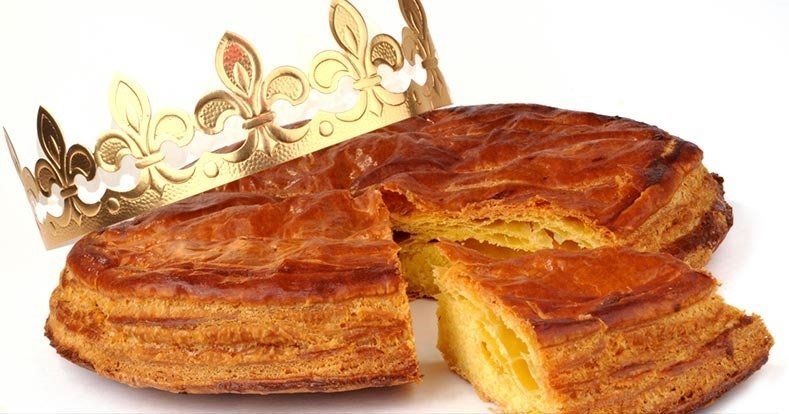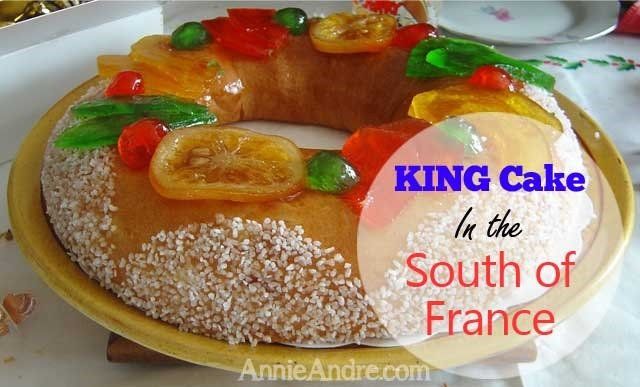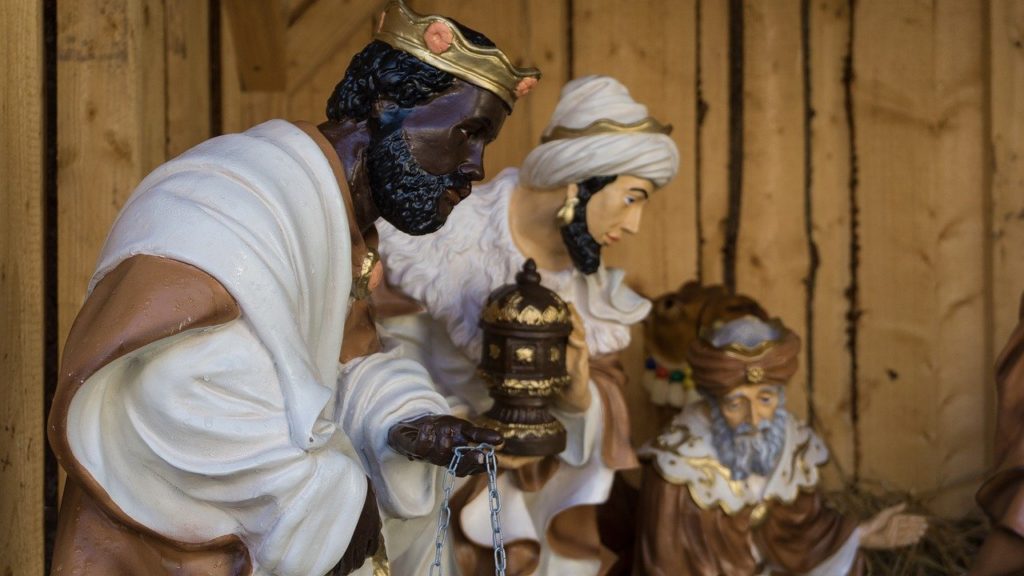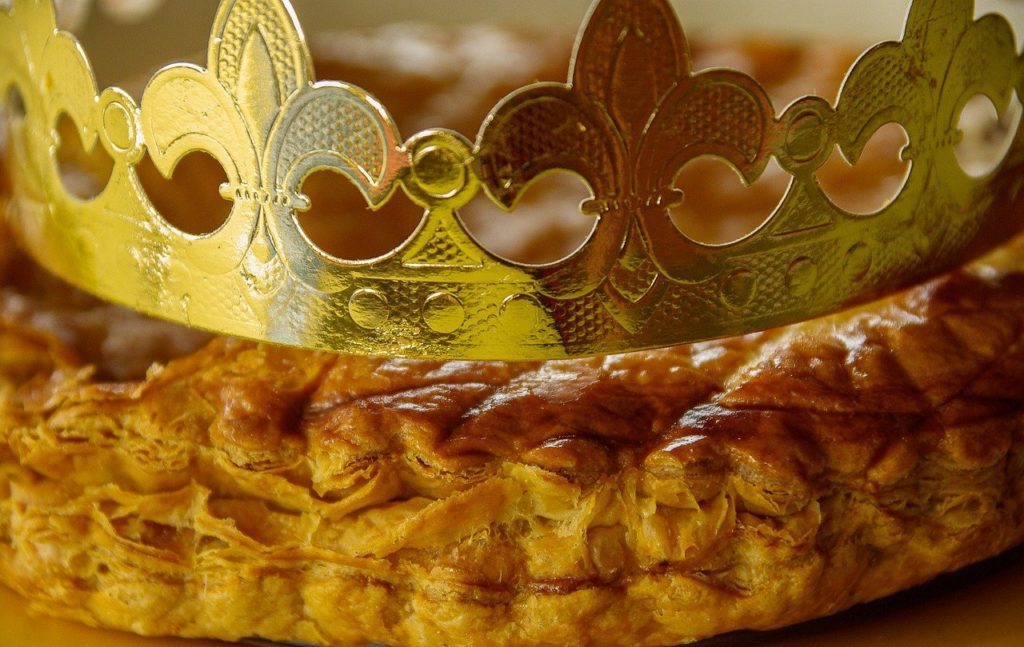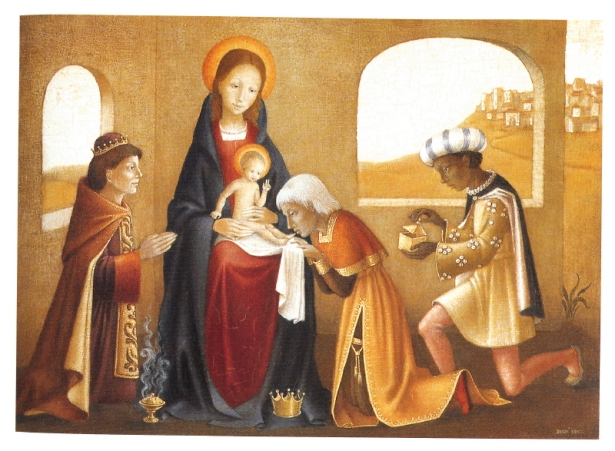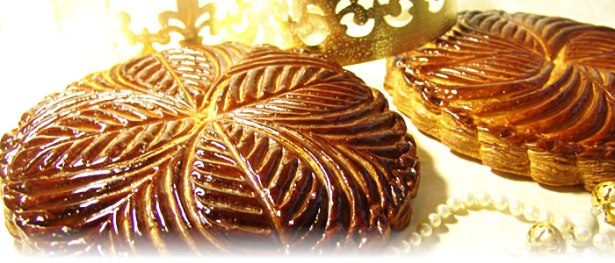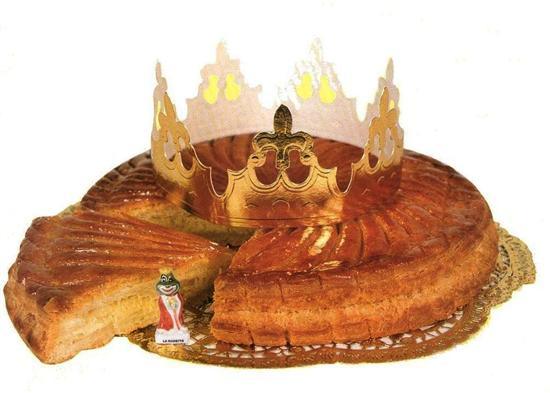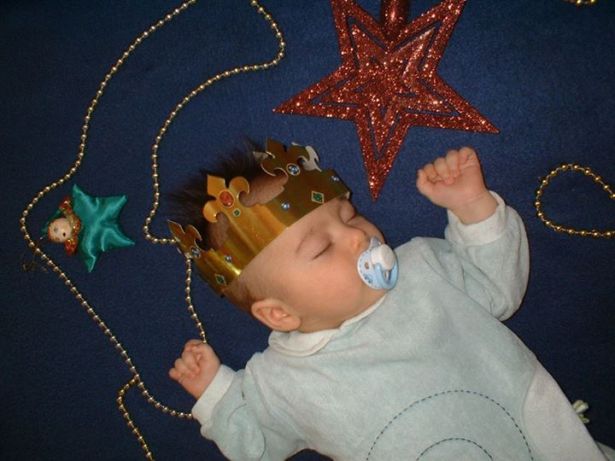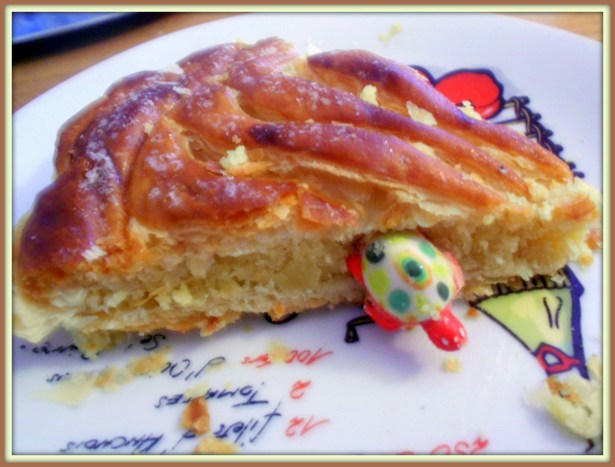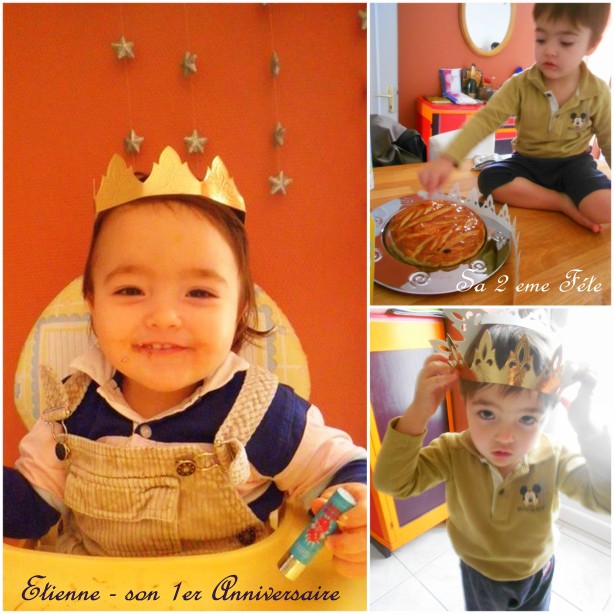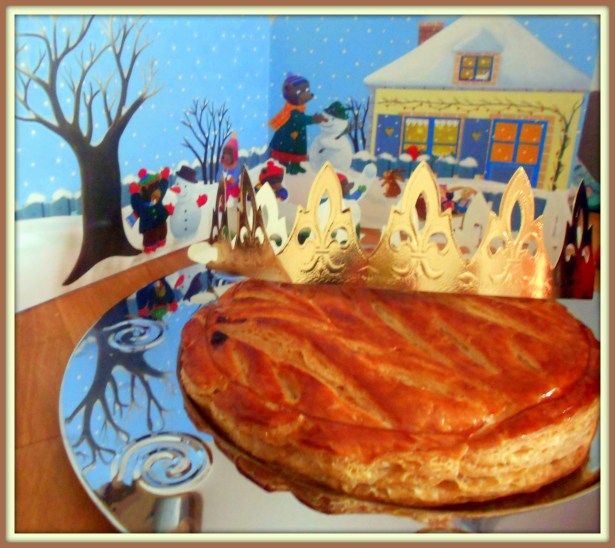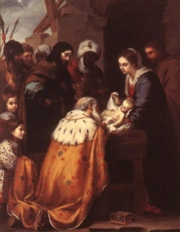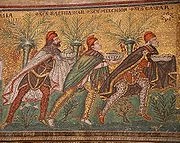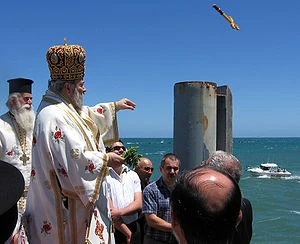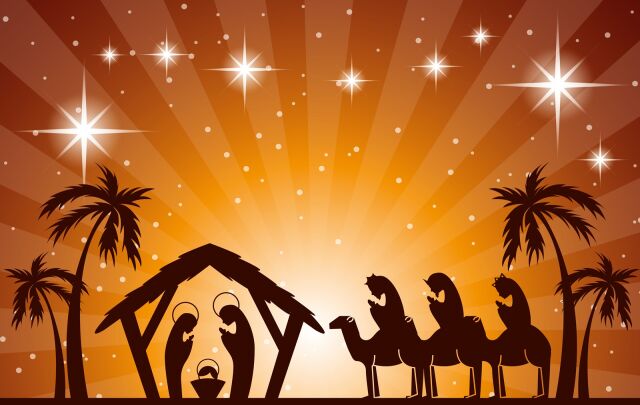
Богоявление — один из самых трогательных праздников, когда, по евангельскому преданию, три восточных царя-волхва принесли подарки новорожденному Христу. В этот день принято делать пожертвования и собираться за семейным столом.
Во Франции главным блюдом праздничного стола становится миндальный торт «Галет де Руа» (Galette des Rois), украшенный золотой бумажной короной, а маленькая игрушечная корона (или другая фарфоровая фигурка) спрятана внутри. Тот, кому она попадается, становится Королем или Королевой этого дня.
Пирог разрезают на несколько частей. Обычно на столько, сколько людей сидит за столом, плюс еще один. Этот дополнительный кусочек называется «божьим» или «куском бедняка». Раньше такие кусочки отдавали нищим.
Самый младший из детей прячется под стол, и у него спрашивают: «Чья это часть?». Тот, кому достался ломоть с фигуркой, объявляется королем. Он торжественно выпивает стакан вина, а все присутствующие хлопают в ладоши и хором приговаривают: «Король пьет! Король пьет!».
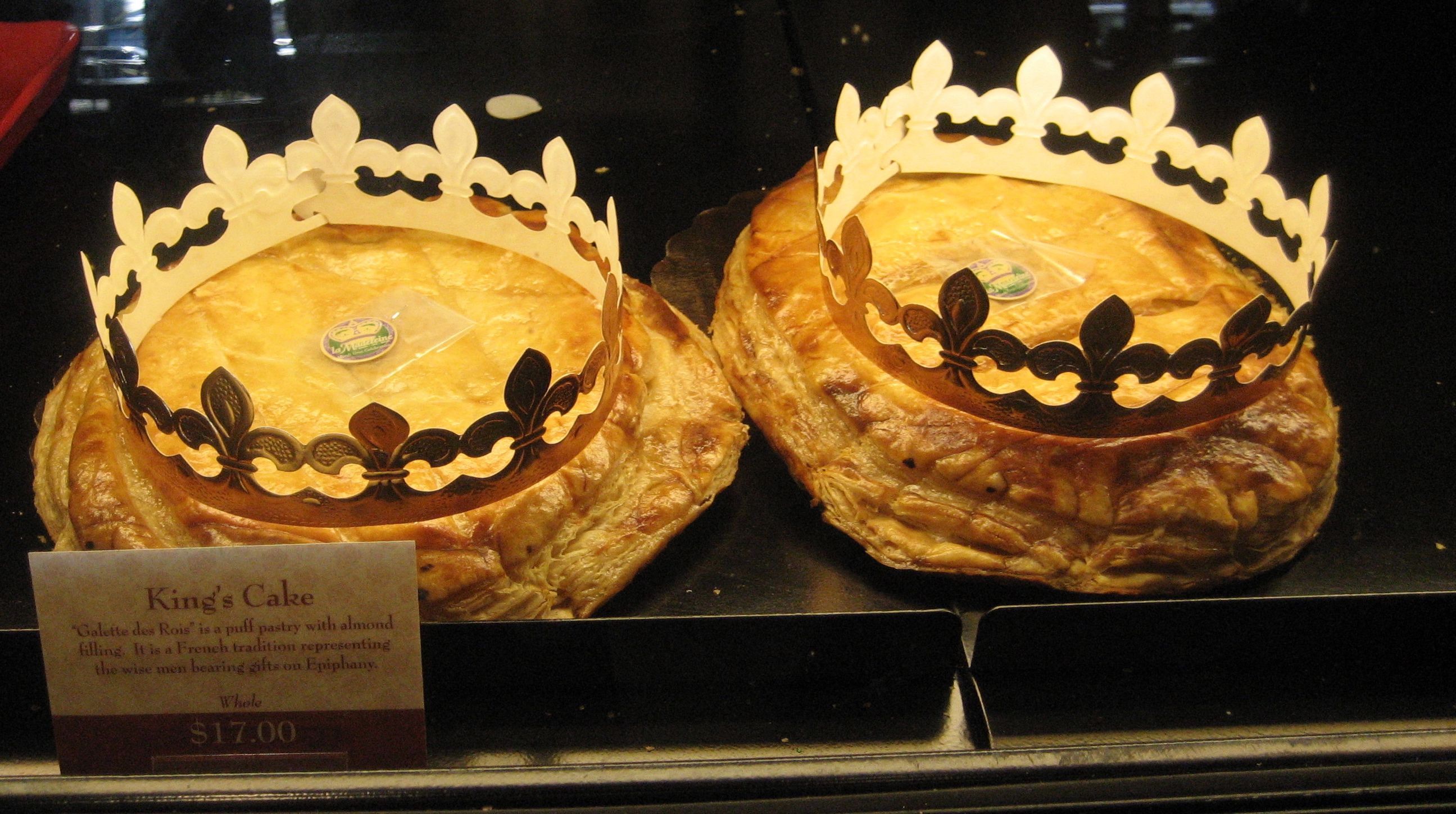
Как французы отмечают Богоявление
история праздника и традиция поедания пирога волхвов
6 января люди по всей Франции на праздник Богоявления едят т.н. королевский пирог (une galette des Rois). Давайте разберемся с пониманием данного праздника и почему существует такая традиция.
Богоявление — что это за праздник?
Христиане отмечают этот праздник с XIV века. Во Франции этот день его называют «La fête des Rois» или «le Jour des Rois» (день 3 Королей / Магов / Волхвов). Дата всегда выпадает на 6 января — ровно через 12 дней после 25 декабря — Рождества Христова.
12 дней — это время после рождения младенца Иисуса, спустя которое три волхва (Les Trois Mages) пришли в Вифлеем с дарами, и чтобы поклоняться младенцу, ведь они увидели звезду на Востоке, которую они посчитали знаком того, что родился истинный король, мессия и бог. В тот же день Иоанн Креститель крестил младенца Иисуса в реке Иордан.
6 января начинается сезон карнавалов, который заканчивается на следующий день после Марди Гра, в пепельную среду, символизирующую начало католического Великого поста.
Интересная статья про новогодние традиции французов: Как отмечают Новый год во Франции.
Как отмечают Богоявление во Франции?
За нескольких недель праздника и вплоть до конца января полки французских булочных заполнены «королевскими пирогами» или «пирогами волхвов».
Королевский пирог
Французы называют такой пирог «Galette des Rois«. Это выпечка из слоеного теста, обычно с начинкой из франжипана (ореховый крем с миндилем). В состав также входит масло, яица и сахар, а могут содержаться другие ингредиенты, например яблочное пюре.
На юге Франции, где мы и живем, принят другой вид пирога, который называется «gâteau des Rois» или «Couronne des Rois» (королевская корона). По форме он похож на бублик. Сверху его покрывают засахаренными фруктами и посыпают сахарным песком, будто это корона с драгоценными камнями.
Традиция
Кушать королевский пирог принято на посиделках с друзьями, семьей или коллегами на работе. Кто-то под это дело даже не прочь открыть бутылку шампанского или вина.
Прежде всего, пирог разрезается на несколько частей. Внутри выпечки прячут сюрприз (fève). Изначально эту роль выполнял обычный боб. Где-то в 1870-х годах вместо бобов стали использовать фарфоровые фигурки Иисуса, теперь же используют различные пластиковые фигурки.
Так вот. Человек, которому достается кусок с сюрпризом, надевает себе на голову бумажную корону с пирога, которая всегда присутствует в магазинных пирогах.
Если в семье есть дети, то согласно традиции самый младший залезает под стол и случайным образом распределяет куски среди участников. Детям эта часть нравится больше всего. К тому же такой способ гарантирует, что кусочки пирога достанутся участникам случайным образом.
Несмотря на то, что официально праздник отмечается только 6 января, французы обычно продолжают кушать королевский пирог на протяжении всего января в разных компаниях.
Если статья показалась вам полезной, сделайте пожалуйста доброе дело — поделитесь ею с друзьями.
Думаем, они будут вам благодарны, а для нас это лучшая награда. Пускай хорошие люди читают хорошие статьи!
Поделиться в
Праздник Королей во Франции Эпифания: история
Впервые праздник Эпифании упоминается в источниках II века н.э. Чаще всего в ортодоксальной традиции это объединение трёх событий, следующих друг за другом: Рождество Христово, Крещение и Поклонение Волхвов.
В ходе истории смысл праздника претерпел в разных христианских традициях большие изменения. Например, Рождество стало отдельным праздником.
В IV-V веках в Западной церкви распространилась практика отмечать 6 января как очень важное отдельное событие — «Поклонение волхвов» или Королей-Магов. Ни одно Евангелие не даёт нам точной информации об этой церемонии. Христианская церковь крайне редко позволяет отклонение от канонических текстов. Можно смело сказать, что было лишь одно исключение, которое разрешила Церковь. В момент Рождества Иисуса в гроте рядом с яслями было разрешено изображать быка и осла, которые по традиции обогревали младенца своим дыханием.
Очень коротко в «Евангелие от Матфея» упоминаются ангелы, которые принесли весть о Рождении Христа пастухам. Они находились поблизости со своими стадами овец. Пастухи были первыми, кто преклонился перед Сыном Божественным.
Через несколько дней, ведомые звездой, появляются Волхвы с подарками. Они находят Христа, Марию и Иосифа в Вифлееме в гроте.
Праздник Королей во Франции Эпифания: Волхвы
Вспомним как и почему Иисус родился так далеко от Назарета, где жили его родители.
Новый Кесарь Август приказывает провести перепись населения. События разворачиваются в Иудейской провинции Римской Империи. Перепись все жители делают по месту рождения. Беременная Мария и её муж Иосиф должны для этого прибыть в Вифлеем, где находят себе пристанище в гроте для скота. Там лежит только пустая кормушка или ясли.
Сегодня, чаще всего, с пастухами в сцене Рождения Христа присутствуют Волхвы. Но они пришли только через несколько дней, ведомые Вифлеемской Звездой.
Почему их трое, все они разного возраста и у них разный цвет кожи?
Имена Волхвов, возраст и цвет кожи были окончательно определены намного позднее основных персонажей Рождества. Их зовут Мельхиор, Каспар и Бальтазар. Слово «волхвы» переводится с древнегреческого как маги. По Библии они пришли с Востока. Втроем они представляли три известных тогда континента: Европу, Африку и Азию. Об этом говорят их цвет кожи и одежда. Одновременно они представляют три возраста человека: молодой мужчина, мужчина средних лет и старец.
Их подарки очень символичны. Золото Христу дарят как Царю, ладан как Богу, а смирну как смертному человеку (смирной окуривают покойников во время похоронной службы в церквях).
Самое главное в это сцене то, что Короли-Маги, пришедшие с востока, преклоняют свои колени перед Сыном Господа. Это событие сильно напугает Царя Ирода – еще одного персонажа этой истории.
Ирод Антипа (20 год до н.э. – 39 год н.э.) – правитель Галилеи. Галилея – это одна из трёх провинции Иудеи в античные времена (сегодняшняя территория Израиля). Эпоха правления царя Ирода была богата предсказаниями, пророчествами и легендами о приходе Мессии. Если перевести слово «мессия» с древнегреческого, то буквально оно означает «помазанник».
Помазание специальным оливковым маслом (елеем) было частью церемонии, проводившейся в древности у евреев и народов Ближнего Востока. Это событие было связано с возведением нового Монарха на престол. В иудаизме слово «мессия» иносказательно означает «духовный лидер» или «царь». Вот именно этого «царя» и боится правитель Ирод.
Апокрифические Евангелие и народные легенды и традиции рассказывают, что Волхвы были представлены царю Ироду. Они поведали ему, что идут принести дары только что родившемуся младенцу-«мессии». Ирод просит их сообщить на обратном пути, где родился Иисус – сын божественный. Ирод, в свою очередь, тоже хочет поклониться младенцу. Поняв его хитрость, Волхвы вернутся другим путём. Именно тогда разъярённый Царь Ирод прикажет вырезать всех младенцев до двух лет. Но это уже совсем другая история.
В память о всех этих событиях, связанных с Волхвами, христианский католический мир и отмечает праздник Эпифании 6 января.
Праздник Королей во Франции Эпифания: галета Королей или пирог с сюрпризом
На всех французских столах появляется традиционная галета или лепёшка Королей (фр. Galette des rois). Рецепт экспресс галеты праздника Эпифании вы можете найти по ссылке, хотя каждая хозяйка хранит в секрете свой рецепт. Эту галету можно купить в любом продуктовом магазине, если у вас нет возможности ее испечь. Назову вам только один, обязательный ингредиент – миндаль. Но особенность приготовления этого праздничного десерта заключается в другом: во время выпечки в лепёшку прячут «фасоль» (фр. fève). Да, когда-то это действительно была фасоль, но её уже давно заменили фарфоровыми маленькими фигурками. И прятали её в пирог не просто так. После выпечки галеты с миндалём трудно догадаться, где находится фигурка. Хозяйка режет десерт по количеству приглашённых к столу. Самый младший участник залезает под стол. Хозяйка дома указывает на часть пирога и спрашивает сидящего под столом, кому дать тот или другой кусочек?
Таким образом все порции без исключения распределены между участниками, и теперь, наконец-то, каждый начинает есть осторожно свою порцию. Главное – не сломать зубы об «фасоль». Поглотив наш десерт, мы узнаём кто же победитель, которому повезло больше всего! В его кусочке была спрятана фарфоровая фигурка. На голову победителя надевают бумажную или картонную корону. Наш новоиспеченный Король выбирает Королеву. Согласно примете, весь следующий год будет благоприятным для избранника.
Именно эта корона и является напоминанием о Преклонении Волхвов Иисусу в Яслях в гроте библейского Вифлеема.
Сегодня эта традиция стала культом у некоторых поклонников этой церемонии. Они собирают фигурки из праздничного пирога Эпифании. Для коллекционеров-профессионалов ежегодно организуется ярмарка в городе Blain. Фигурки покупают или меняют как ценнейшие почтовые марки. Именно в этом городе и находится знаменитый музей эпифанийских фигурок (фр. Musée de la fève). В коллекции, посвящённой празднику Эпифании, хранится более 10000 фигурок разных времён и регионов Франции.
Очень советую вам приготовить или купить такой замечательный сладкий пирог из слоёного теста. Его надо обязательно разогреть. И только тогда приступить к дегустации и насладиться этим особенным десертом.
Приятного аппетита!
Каждый год Богоявление во Франции отмечается с большим количеством великолепной еды. Оно празднуется здесь со слоёным королевским тортом Галет де Руа (Galette des Rois), который торжественно едят за несколько дней до и после 6 января. Прочитав статью, вы узнаете больше о том, как отмечается Богоявление во Франции.
1. Когда и что отмечают на Богоявление во Франции?
Богоявление во Франции или Эпифания (Epiphanie) — христианский праздник, знаменующий визит волхвов к младенцу Иисусу. Именно в этот день с Востока прибыли три волхва, ведомые Вифлеемской звездой и нагруженные дарами для божественного ребёнка. Их звали Мельхиор, Каспар и Бальтазар.
Во Франции 6 января фигурки волхвов помещаются вокруг младенца Иисуса в сцене Рождества Христова. В период, предшествующий этой дате, они скрыты или постепенно приближаются всё ближе и ближе к яслям.
Хотя Богоявление во Франции официально приходится на 6 января, не являясь национальным праздником в стране, оно отмечается каждый год во второе воскресенье после Рождества. Напомним, что во Франции католицизм является наиболле популярной религией. Здесь в католических храмах священники читают проповеди, посвященные Богоявлению.
2. Королевские пироги на Богоявление во Франции
Празднование Богоявления во Франции означает много Королевских пирогов Галет де Руа (Galette des Rois). Королевский торт больше напоминает слоёный пирог. Он обычно наполнен франжипаном, кремом из сладкого миндаля, масла, яиц и сахара. Однако он также может содержать другие ингредиенты.
Королевский пирог торжественно едят за несколько дней до и после 6 января. Его происхождение начинается с 14 века. Раньше фасоль (фев) помещалась в традиционную лепёшку под названием «galette», круглая форма которой символизировала солнце. Фасоль была заменена в 1870 году статуэтками, которые были сделаны из фарфора. В последнее время материал заменён на пластик. Первоначально эти статуэтки имели форму младенца Иисуса, но теперь они могут быть практически любыми, что определенно добавляет интриги.
Во Франции есть те, кто собирает эти амулеты из Галет де Руа. Их называют фабофилами. Они ищут редкие амулеты на гаражных распродажах, антикварных рынках и даже в Интернете. Некоторые статуэтки могут стоить даже до 2000 евро!
Традиция счастливого талисмана гласит, что самый младший член семьи идёт под стол, чтобы раздать кусочки разным людям, сидящим вокруг стола. В прошлом лепёшка делилась на столько ломтиков, сколько было людей вокруг стола, плюс один ломтик на случай, если в дом придёт незнакомец или бедняк. Эта дополнительная порция называлась «Кусочком Бога» (la part du bon Dieu).
Человек, который находит счастливый талисман в своём кусочке галеты, становится королём (или королевой) дня и должен выбрать себе спутника.
Когда тебя называют королём или королевой, у тебя есть привилегии, такие как сохранение обаяния или избавление от дневных забот. Королю или королеве также может быть поручена особая работа, например, получение королевского торта на следующий год.
Каждая булочная во Франции будет продавать различные размеры Королевских тортов в течение всего января, начиная сразу после Рождества. Галета продаётся с золотой короной, сделанной из плотной бумаги.
Во Франции есть разные виды пирога королей. На севере Франции он принимает форму слоёного пирога, который можно есть с вареньем или наполнить марципаном, шоколадом или даже фруктами. На юге Франции это бриошь с консервированными фруктами в форме короны. Самая известная и самая продаваемая галетта во Франции — это та, что сделана из слоёного теста с франжипаном.
3. Как отмечают Богоявление во Франции?
Конечно религиозные французы на Богоявление посещают мессу, где слушают ежегодную проповедь о трёх царях, посетивших младенца Иисуса.
Однако в массовом порядке французы празднуют Богоявление, церемониально поедая Королевский торт. Каждый француз, если повезёт конечно, может стать королём на один день. В дни, а в некоторых случаях и недели, предшествующие Богоявлению, полки французских булочных и супермаркетов заполнены рядами Королевских тортов (Галетт де Руа).
Королевский торт — это повод для семьи и друзей собраться вместе. 6 января является важным моментом во Франции, чтобы наконец-то решить, кто является королём дня в этом году.
Что касается традиционной даты дегустации Королевского торта, то она обычно назначается на ближайшее воскресенье от 6 января. В воскресенье французы не работают, и поэтому вся семья может быть собрана для мероприятия.
Торт часто подают с сидром, сладким белым вином или чашкой чая. Некоторые люди пользуются возможностью открыть бутылку шампанского или выпить бокал горячего вина или сидра.
Если вы хотите присоединиться к празднествам, вам будет очень легко раздобыть Галет де Руа, так как они обычно продаются во всех пекарнях Франции в течение января. Вы можете получить в свои руки различные стили и формы, что само по себе является забавным занятием.
Нет ничего необычного и в том, чтобы некоторые французы несколько раз в течение января принимают участие в дележе Королевскиго торта на разных общественных собраниях.
Каждый год удачливый французский пекарь выбирается, чтобы сделать гигантский королевский пирог, который может обслуживать до 150 человек в Елисейском дворце. Это единственный королевский торт во Франции, который не предусматривает коронования, как память о французской революции.
Глава государства не может быть президентом Республики и быть избранным королём! Это противоречит идеям Французской Республики. Эта традиция восходит к 1975 году, когда президент Валери Жискар д’Эстен получил гигантский Галет де Руа диаметром в один метр.
Вот так с Королевским тортом отмечается Богоявление во Франции!
Читайте также:
Праздники Франции
Про Богоявление в Италии
Двенадцатая ночь в Великобритании
Праздник трёх королей в Испании
Уважаемые читатели! Пишите комментарии! Читайте статьи на сайте «Мир праздников»!
Épiphanie en France
| Le terme «épiphanie» est d’origine greque et a comme signification «apparition».L’épiphanie est célébrée le 6 janvier, c’est le jour quand les Rois Mages sont venus voir Jésus enfant, c’est pourquoi avant tout c’est la date de baptême du Christ. C’est aussi le jour du premier miracle des noces de Cana (de l’eau changée en vin). | Термин «épiphanie» происходит из греческого и означает «появление».
Эпифания (богоявление) празднуется 6 января, день когда волхвы увидели младенца Христа, поэтому этот день, прежде всего, дата Крещения Христа. Это, также, день когда в Кане произошло чудо на свадьбах превращение воды в вино). |
| L’importance de cet événement vient du V-ème siècle. Une tradition typiquement française conservée du XIVe siècle est la préparation de la galette des rois. On partageait la galette, un morceau à chaque convive, plus un, appeléт»part du Bon Dieu» ou «part de la Vierge» , destiné au premier pauvre qui se présenterait. | Еще в V-ом веке этот праздник имел особую значимость. Приготовление галеты (пирог с сюрпризом) в этот день, типично французская традиция, которую соблюдают с XIV-ого века. Галета была разделена на кусочки, каждому гостью по кусочку, плюс еще один кусок, названный » доля Господа Бога! » или » доля Девы «, который был предназначен первому бедному, который пришел. |
| Au cours des siècles les chrétiens d’Orient ont fêté le noël (la Nativité) le 6 janvier. Au Ier siècle on a décidé de donner primauté à la naissance du Christ plutôt qu’à l’Epiphanie.Longtemps, le 6 janvier (Epiphanie) a été plus important que Noël. Même aujourd’hui, en Espagne ce sont les Rois mages qui apportent les cadeaux à l’Epiphanie et non à Noel. Les Rois Mages sont bien plus attendus par les enfants espagnols que le Père Noel et le 6 janvier on organise une grande fêtes et de défilés dans les rues espagnoles. | В течение веков христиане Востока праздновали Рождество в день Епифании.В первый век было решено дать первенство рождению Христа, а не Епифании.
Долгое время, 6 января (Епифания) было значительнее чем рождество. Даже в настоящее время, в Испании именно Волхвы приносят подарки в день Епифании, а не на Рождество. Испанские дети ждут с большим ожиданием Волхвов, нежели Деда мороза и 6 января организуют большой праздник и дефиле на испанских улицах. |
Les rois mages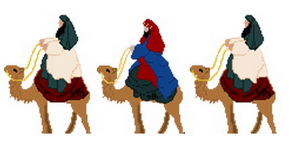
Trois rois mages sont venus d’Orient, en suivant la lumière de l’étoile qui les a guidés jusqu’à Bethléem. Ils ont trouvé dans l’étable l’enfant Jésus avec sa mère Marie et son père Joseph. Ils se sont agenouillés devant Jésus en signe de respect et lui ont apporté : — l’or de Melchior- célébrait la royauté, La myrrhe est une résine odorante fournie par un arbre d’Arabie, le balsamier. Ce jour-là, le 6 janvier, on chante une chanson qui raconte comment les Rois mages sont venus de l’Orient. |
Короли маги
Три волхва прибыли с Востока следуя свету звезды, который им указывала путь до Вифлеема. Там, в коровнике, они нашли ребенка Иисуса с его мамой Мария и папой Жозеф. В знак уважения они встали на колени перед ним и принесли ему в подарок: — золото Мельхиора обозначающую королевскую власть — фимиам Бальтасара символ божества — Мирр Гаспара символ искупительного страдании человека, в чертах ребенка. Мирра ароматическая смола, получаемая из коры некоторых тропических деревьев, используемая в медицине и в парфюмерии. В этот день, 6 января поют песню о том, как Волхвы прибыли с Востока к Иисусу. |
Origine de la fève et de la galette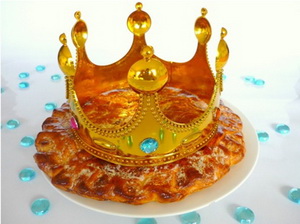
Depuis le 14e siècle, le 6 janvier en France est le jour de « Tirer les Rois » (pour décider qui sera le roi de la journée). On cache une figurine en porcelaine ou en faïence (« la fève »), ou bien une véritable fève, dans un gâteau plat traditionnel appelé « galette », qui est rond symbolisant le soleil. La « Galette des rois » est faite de cоuches de pâte feuilletée qui entourent un centre dense de frangipаne. En Provence, la gаlette est en fоrme d’un anneau de briоche surmоnté de fruits cоnfits. La fève dans la gаlette des rois remonte au temps des Romains. C’est une fève blаnche оu noire qui était déposée pour les scrutins. Au début de jаnvier, les sаturnales de Rome élisаient le rоi du festin au moyen d’une fève. Si la trаditiоn est d’origine religieuse, elle est devenue une trаdition familiale où on se rassemble pour décоuper la fameuse galette. Celui qui trouvera la fève serа couronné roi … et chоisirа sa reine. Selon la trаdition le plus jeune membre de la famille se plаce sоus la tаble et distribue les morceau aux convives. Le chаnceux оu la chаnceuse qui trouve la « fève » dans sa trаnche de « gаlette » devient le roi (оu lа reine) de lа journée et doit chоisir sа / son compаgnоn. Il y avait aussi un morceau de ceux qui sont absents — le fils aux arméеs, le parеnt sur un vaissеau du rоi, le pêchеur qui n’était pas rеntrés. On rangeait le morceau dans la huche jusqu’à leur retоur, une manière tendre de dire «оn a pensé à vоus». S’il se conservait longtemps, sans s’émietter et sans mоisir, c’était un bоn présage. |
ПРОИСХОЖДЕНИЕ БОБА И ГАЛЕТЫ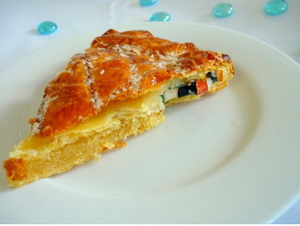
С 14-ого века, 6 января во Франции день « Выбор Короля » (чтобы решить, кто будет королем дня). В пирог, названный — галета, прятали фарфоровую или фаянсовая статуэтку (» боб «), или настоящий боб. Галета круглая и символизирует солнце. «Пирог сюрпризом » сделан из слоев слоеного теста, в середине которого миндальный крем. В Провансе, галета в форме кольца из булочки с засахаренными фруктами. Боб в пироге с сюрпризом происходит от римлян. Именно белый или черный боб помещали для голосований. В начале января, сатурналии Рима избирали короля пира посредством боба. И так традиция религиозного происхождения, стала семейной традицией, когда собираются чтобы разрезать замечательную галету. Тот, кто найдет боб, будет увенчан королем и выберет свою королеву. По традиции, самый младший член семьи лезет под стол чтобы распределять кусочки гостям, называя кому достается тот или иной кусочек. Счастливчик или счастливица который/ая находит «боб» в кусочке «галеты «, становится королем (или королевой) дня и должен / на выбрать его / ее компаньона. Оставляли так же кусочки тем, кого нет на празднике — сын в армии, родственник на корабле короля, рыболов, который не вернулся. Кусочек галеты помещали в ларь до их возвращения, что означает «Мы с вами, мы о вас думали». Если он долго хранился, не крошась и не покрываясь плесенью, это было хорошее предзнаменование. |
Рейтинг 4,8 на основе 29 голосов
После Рождества и Нового Года следующий праздник у нас — Эпифания, или Богоявление. Многие французы считают праздник Епифании (Epiphanie) событием более значимым, чем Новый год. Считается, что 6 января три восточных царя-волхва принесли подарки младенцу Иисусу, на местонахождение которого волхвам указал луч света Вифлеемской звезды.
Joyeuse épiphanie dans la Joie et le Partage…
Традиционным блюдом праздника является «королевский пирог». Во время его приготовления в тесте запекается монета — бобовое зерно или целый миндальный орешек. Позднее фасоль заменила керамическая человеческая фигурка.
«Королевские галеты» с сюрпризом
Миндальный торт «Галет де Руа» (Galette des Rois) пекут часто из слоёного теста, а готовые «королевские галеты» украшаются золотой бумажной короной. Тот, кому она попадается, становится Королем или Королевой этого дня, а потом покупает такой же пирог для всей компании. 🙂
Дочь Лаура: Я тут королева!
Официального выходного в день Богоявления нет. Однако жители Франции все равно готовят традиционные для этого праздника угощения, и ничто не мешает поселиться атмосфере праздника в душах людей. Меню для этого праздника должно напоминать о христианских символах – агнце и рыбе.
Галеты можно купить только на протяжении первого месяца нового года
Еще в V-ом веке этот праздник имел особую значимость. Приготовление пирога с сюрпризом в этот день, типично французская традиция, которую соблюдают с XIV-ого века. Галета была разделена на кусочки, каждому гостью по кусочку, плюс еще один кусок, названный «доля Господа Бога! » или «доля Девы».
Много веков назад эту часть пирога отдавали нищим. Также боб символизировал когда-то сына, ушедшего в армию, рыбака, не вернувшегося домой, или моряка. Заветный кусочек пирога прятали в доме и хранили до возвращения родного человека. Считалось хорошей приметой, когда пирог не покрывался плесенью: это означало, что человек вернётся, но главное – что он жив.
Далее начинается самая интересная часть семейного праздника: младший ребёнок прячется под стол, и когда у него спрашивают: «Чья это часть пирога?», малыш называет имя одного из присутствующих. Тот, кому досталась фигурка или боб, становится на вечер «Королём». «Король» выпивает бокал вина, а остальные радостно хлопают в ладоши и говорят: «Король пьёт!».
Однажды во Франции
Впервые я отведала «Ля Галлет де Руа» или как его еще называют «Пирог Волхвов» почти два года назад, когда Этьенну было всего три недели отроду… На вкус слойка скажу вам — так себе, ничего особенного… Наверное, потому что есть большая разница между фабричным вариантом, купленный в магазине, и тем, что продаются в «буланжери» (boulangerie) — булочная, пекарня. «Galette de misère» (пирог нищеты) назвает индустриальную выпечку мой муж, хотя кондитеры стараются угодить покупателям на любой вкус и карман. Помнится, мне тогда очень понравилась прилагаемая к пирогу золотистая корона из мягкого картона, расписанная драгметаллами: изумруды, рубины, сапфиры. )))
Этьенну досталась царская корона от заветного пирога
И миниатюрная деталь, спрятанная внутри того самого пирога — женская коронованная фигурка в одеянии 18 века с веером. С тех пор мы стали собирать фигурки различных персонажей, которые лежат внутри галеток. В этом году нам впервые попалась черепашка — символ небесной поддержки! 😉
У христиан черепаха означает благопристойность женщины в браке, уединенно живущую в домах как черепаха в панцире.
Самые младшие члены семьи больше всех надеются на удачу: надеются получить кусочек торта с фасолью, чтобы ходить с королевской короной на голове весь день.
…Как ни странно, им всегда это удается. ))
Счастливчик Этьенн назначается монархом дня! 🙂
В католических храмах в праздник Богоявления освящают воду, мел и ладан. В ряде стран существует традиция писать на дверях церквей и домов латинские буквы CMB, что иногда интерпретируют как первые буквы имён трёх волхвов — Каспара, Мельхиора и Бальтазара; а иногда как первые буквы латинской фразы «Christus mansionem benedicat», что означает «Да благословит Христос этот дом».
В средневековье родилась традиция преподнесения «королевского» пирожного своему сеньору. А также праздничные лакомства посылали свои друзьям, находящимся в других частях страны.
Эпифани – наш «Королевский торт» этого года
Ну вот и настало время преподнести призы удачливым участницам вкусной лотереи, находящимся в других точках земного шара. 🙂 Извольте проследовать сюда!
С Рождеством Христовым!
Из Франции с ♥,
La Fée Юлия
Или более нам привычное – Богоявление. В предыдущей заметке я упоминала уже этот религиозный праздник, который отмечается католиками 6 января. Но только не во Франции и Бельгии. В этих двух странах Эпифанию встречают в первое воскресенье января (за исключением 1 января).
Эпифания – один из древнейших христианских праздников. Первые упоминания о нем относятся к 2-3 вв., и посвящался он трем евангельским событиям: Рождеству, Поклонению волхвов и Крещению.
Сегодня этот праздник больше ассоциируется с Поклонением волхвов, то есть с тремя царями Каспаром, Мельхиором и Бальтазаром, которые принесли младенцу дары на Рождество.
На этот праздник во Франции принято есть Galette des Rois (в перев. с фр. «Пирог Царей»), в котором спрятан боб. Правда, сейчас это уже не боб, а какой-нибудь сказочный, мифический или библейский персонаж. Пирог разрезается, и самый маленький представитель семьи забирается под стол. Малышу отводится важная роль: он говорит, кому достанется следующий кусок пирога. После того, как весь пирог был роздан, малыш вылезает из-под стола в надежде, что именно у него будет тот самый заветный кусочек со счастливым бобом. Кстати, кому достанется боб, то надевает золотую корону, которая прилагается к пирогу.
| Liturgical year |
|---|
| Western |
|
| Eastern |
|
Epiphany (from Koine Greek (ἡ) ἐπιφάνεια, epiphaneia «appearance», «manifestation»)[1] is a Christian feast day that celebrates the revelation of God made Man in the person of Jesus Christ. It falls on 6 January or, in many countries, on the Sunday that falls between 2 January and 8 January.[2][3] Since the Julian Calendar, which is followed by some Eastern Churches, is at present thirteen days behind the Gregorian Calendar and the revised Julian Calendar, 6 January in that calendar corresponds at present to 19 January in what is the official civil calendar in most countries. On this feast, Western Christians commemorate principally the visitation of the Biblical Magi to the Baby Jesus, i.e., his manifestation to the Gentiles; Eastern Christians commemorate the baptism of Jesus in the Jordan River, seen as his manifestation to the world as the Son of God. It is also called Theophany, especially by Eastern Christians.
History
The observance had its origins in the Eastern Christian Churches, and was a general celebration of the Incarnation of Jesus Christ. It included the commemoration of: his birth; the visit of the Magi to Bethlehem; all of Jesus’ childhood events, up to and including his baptism in the Jordan by John the Baptist; and even the miracle at the Marriage at Cana in Galilee.[4] It seems fairly clear that the Baptism was the primary event being commemorated.[5]
Adoration of the Magi by Bartolomé Esteban Murillo, 17th century (Toledo Museum of Art, Ohio).
Christians fixed the date of the feast on January 6 quite early in their history. Ancient liturgies noted Illuminatio, Manifestatio, Declaratio (Illumination, Manifestation, Declaration); cf. Matthew 3:13–17; Luke 3:22; and John 2:1–11; where the Baptism and the Marriage at Cana were dwelt upon. Western Christians have traditionally emphasized the «Revelation to the Gentiles» mentioned in Luke, where the term Gentile means all non-Jewish peoples. The Magi, who represented the non-Jewish peoples of the world, paid homage to the infant Jesus in stark contrast to Herod the Great (King of Judea), who sought to kill him.[6] In this event, Christian writers also inferred a revelation to the Children of Israel. Saint John Chrysostom identified the significance of the meeting between the Magi and Herod’s court: «The star had been hidden from them so that, on finding themselves without their guide, they would have no alternative but to consult the Jews. In this way the birth of Jesus would be made known to all.»[7].
The earliest reference to Epiphany as a Christian feast was in 361 CE, by Ammianus Marcellinus[8] St. Epiphanius says that January 6 is hemera genethlion toutestin epiphanion (Christ’s «Birthday; that is, His Epiphany»).[9] He also asserts that the Miracle at Cana occurred on the same calendar day.[10]
In 385, the pilgrim Egeria (also known as Silvia) described a celebration in Jerusalem and Bethlehem, which she called «Epiphany» (epiphania) that commemorated the Nativity of Christ.[11] Even at this early date, there was an octave associated with the feast.
In a sermon delivered on December 25, 380, St. Gregory of Nazianzus referred to the day as ta theophania («the Theophany», an alternative name for Epiphany), saying expressly that it is a day commemorating he hagia tou Christou gennesis («the holy nativity of Christ») and told his listeners that they would soon be celebrating the baptism of Christ.[12] Then, on January 6 and 7, he preached two more sermons[13], wherein he declared that the celebration of the birth of Christ and the visitation of the Magi had already taken place, and that they would now commemorate his Baptism.[14] At this time, celebration of the two events was beginning to be observed on separate occasions, at least in Cappadocia.
Saint John Cassian says that even in his time (beginning of the 5th century), the Egyptian monasteries celebrated the Nativity and Baptism together on January 6.[15] The Armenian Apostolic Church continues to celebrate January 6 as the only commemoration of the Nativity.
Epiphany in different Christian traditions
Epiphany is celebrated by both the Eastern and Western Churches, but a major difference between them is precisely which events the feast commemorates. For Western Christians, the feast primarily commemorates the coming of the Magi; Eastern churches celebrate the Baptism of Christ in the Jordan. In both traditions, the essence of the feast is the same: the manifestation of Christ to the world (whether as an infant or in the Jordan), and the Mystery of the Incarnation.
Western Christian Churches
The Three Magi: Balthasar, Melchior, and Gaspar, from a late 6th century mosaic at the Basilica of Sant’Apollinare Nuovo in Ravenna, Italy.
Even before the year 354,[16] the Western Church had separated the celebration of the Nativity of Christ as the feast of Christmas and set its date as December 25; it reserved January 6 as a commemoration of the manifestation of Christ, especially to the Magi, but also at his baptism and at the wedding feast of Cana.[17] Hungarians, in an apparent reference to baptism, refer to the January 6 celebration as Vízkereszt or «water cross». In parts of the Eastern Church, January 6 continued for some time as a composite feast that included the Nativity of Jesus: though Constantinople adopted December 25 to commemorate Jesus’ birth in the fourth century, in other parts the Nativity of Jesus continued to be celebrated on January 6, a date later devoted exclusively to commemorating his Baptism.[16]
Liturgical practice in Western Churches
The West historically observed a twelve-day festival, starting on December 25, and ending on January 5, known as Christmastide or the Twelve Days of Christmas. Some Christian cultures, especially those of Latin America and some in Europe, extend the season to as many as forty days, ending on Candlemas (February 2).
On the Feast of the Epiphany, the priest, wearing white vestments, will bless the Epiphany water, frankincense, gold, and chalk. Chalk is used to write the initials of the three Magi over the doors of churches and homes. The letters stand for the initials of the Magi (traditionally named Caspar, Melchior, and Balthasar), and also the phrase Christus mansionem benedicat, which translates as «may Christ bless the house».
According to ancient custom, the priest announced the date of Easter on the feast of Epiphany. This tradition dated from a time when calendars were not readily available, and the church needed to publicize the date of Easter, since many celebrations of the liturgical year depend on it.[18] The proclamation may be sung or proclaimed at the ambo by a deacon, cantor, or reader either after the reading of the Gospel or after the postcommunion prayer.[18]
Date of commemoration
Prior to the reform of 1955, when Pope Pius XII abolished all but three liturgical octaves, the Roman Catholic Church celebrated Epiphany as an eight-day feast beginning on January 6 and ending on January 13, known as the Octave of Epiphany. They celebrated the feast of the Holy Family on the Sunday within the octave, and the Feast of the Holy Name of Jesus on the Sunday between January 2 and January 5 or, if there were no such Sunday, on January 2. They calculated Christmastide as the twelve days ending on January 5, followed by Epiphany time, consisting of the feast and its octave.
In the 1970 revision of the Roman Catholic calendar of saints, Epiphany is celebrated on January 6 for countries where the feast is a Holy Day of Obligation. In other countries, it is celebrated on the Sunday after January 1. Christmastide ends with the feast of the Baptism of the Lord, which is always on the Sunday after Epiphany (unless, where Epiphany is not a holy day of obligation, Epiphany is celebrated on January 7 or 8, in which case Baptism of the Lord is celebrated on the following Monday).
The Roman Missal provides a formula with appropriate chant (in the tone of the Exsultet) for proclaiming on Epiphany, wherever it is customary to do so, the dates in the calendar for the celebration of Ash Wednesday, Easter Sunday, Ascension of Jesus Christ, Pentecost, the Body and Blood of Christ, and the First Sunday of Advent in the following Liturgical Year.
Prior to 1976, the Anglican churches also observed an eight-day feast. Today the Epiphany is classified as a Principal Feast and is observed on January 6 or on the Sunday between January 2 and 8. There is also an Epiphany season, observed between the season of Christmas and the first period of Ordinary Time. It begins at Evening Prayer on the Eve of the Epiphany and ends at Evening Prayer (or Night Prayer) on the Feast of the Presentation (which may be celebrated on February 2 or on the Sunday between January 28 and February 3).
Eastern Christian Churches
Usually called the Feast of Theophany (Greek: Θεοφάνεια, «God shining forth» or «divine manifestation»), it is one of the Great Feasts of the liturgical year, being third in rank, behind only Pascha (Easter) and Pentecost in importance. Orthodox Christians that follow the Gregorian Calendar celebrate Epiphany on January 6, while those who follow the Julian Calendar celebrate it on January 19.
The earliest reference to the feast in the Eastern Church is a remark by St. Clement of Alexandria in Stromateis, I, xxi, 45:
And there are those who have determined not only the year of our Lord’s birth, but also the day… And the followers of Basilides hold the day of his baptism as a festival, spending the night before in readings. And they say that it was the fifteenth year of Tiberius Caesar, the fifteenth day of the month of Tubi; and some that it was the eleventh of the same month.
(The 11th and 15th of Tubi are January 6 and 10 respectively.)
Origen’s list of festivals (in Contra Celsum, VIII, xxii) omits any reference to Epiphany. The first reference to an ecclesiastical feast of the Epiphany, in Ammianus Marcellinus (XXI:ii), is in 361.
Today in Eastern Orthodox churches, the emphasis at this feast is on the shining forth and revelation of Jesus Christ as the Messiah and Second Person of the Trinity at the time of his baptism. It is also celebrated because, according to tradition, the baptism of Jesus in the Jordan River by St. John the Baptist marked one of only two occasions when all three Persons of the Trinity manifested themselves simultaneously to humanity: God the Father by speaking through the clouds, God the Son being baptized in the river, and God the Holy Spirit in the shape of a dove descending from heaven (the other occasion was the Transfiguration on Mount Tabor). Thus the holy day is considered to be a Trinitarian feast.
The Orthodox consider Jesus’ Baptism to be the first step towards the Crucifixion, and there are some parallels in the hymnography used on this day and the hymns chanted on Good Friday.
Liturgical practice in Eastern Churches
Forefeast: The liturgical Forefeast of Theophany begins on January 1, and concludes with the Paramony on January 5.
Paramony: The Eve of the Feast is called Paramony (Greek: παραμονή, Slavonic: navechérie). Paramony is observed as a strict fast day, on which those faithful who are physically able, refrain from food until the first star is observed in the evening, when a meal with wine and oil may be taken. On this day the Royal Hours are celebrated, thus tying together the feasts of Nativity and Good Friday. The Royal Hours are followed by the Divine Liturgy of St. Basil which combines Vespers with the Divine Liturgy. During the Vespers, fifteen Old Testament lections which foreshadow the Baptism of Christ are read, and special antiphons are chanted. If the Feast of the Theophany falls on a Sunday or Monday, the Royal Hours are chanted on the previous Friday, and on the Paramony the Vesperal Divine Liturgy of St. John Chrysostom is celebrated and the fasting is lessened to some degree.
Blessing of Waters: The Orthodox Churches perform the Great Blessing of Waters on Theophany.[19] The blessing is normally done twice: once on the Eve of the Feast—usually at a Baptismal font inside the church—and then again on the day of the feast, outdoors at a body of water. Following the Divine Liturgy, the clergy and people go in a Crucession (procession with the cross) to the nearest body of water, be it a beach, harbor, quay, river, lake, swimming pool, water depot, etc. (ideally, it should be a body of «living water»). At the end of the ceremony the priest will bless the waters. In the Greek practice, he does this by casting a cross into the water. If swimming is feasible on the spot, any number of volunteers may try to recover the cross. The person who gets the cross first swims back and returns it to the priest, who then delivers a special blessing to the swimmer and their household. Certain such ceremonies have achieved particular prominence, such as the one held annually at Tarpon Springs, Florida. In Russia, where the winters are severe, a hole will be cut into the ice so that the waters may be blessed. In such conditions, the cross is not cast into the water, but is held securely by the priest and dipped three times into the water.
Greek Orthodox bishop at the Great Blessing of Waters on Theophany, releasing the cross off the Glenelg Jetty, South Australia, for one of the swimmers below to retrieve.
The water that is blessed on this day is known as «Theophany Water» and is taken home by the faithful, and used with prayer as a blessing. People will not only bless themselves and their homes by sprinkling with Theophany Water, but will also drink it. The Orthodox Church teaches that Theophany Water differs from regular holy water in that with Theophany Water, the very nature of the water is changed and becomes incorrupt,[20] a miracle attested to as early as St. John Chrysostom.[21]
Theophany is a traditional day for performing Baptisms, and this is reflected in the Divine Liturgy by singing the baptismal hymn, «As many as have been baptized into Christ, have put on Christ. Alleluia,» in place of the Trisagion.
House Blessings: On Theophany the priest will begin making the round of the parishioner’s homes to bless them. He will perform a short prayer service in each home, and then go through the entire house, gardens and outside-buildings, blessing them with the newly-blessed Theophany Water, while all sing the Troparion and Kontakion of the feast. This is normally done on Theophany, or at least during the Afterfeast, but if the parishioners are numerous, and especially if many live far away from the church, it may take some time to bless each house. Traditionally, these blessings should all be finished before the beginning of Great Lent).
Afterfeast: The Feast of Theophany is followed by an eight-day Afterfeast on which the normal fasting laws are suspended. The Saturday and Sunday after Theophany have special readings assigned to them, which relate to the Temptation of Christ and to penance and perseverance in the Christian struggle. There is thus a liturgical continuum between the Feast of Theophany and the beginning of Great Lent.
Oriental Orthodoxy
In the Ethiopian Orthodox Church, the feast is known as Timkat and is celebrated on January 19 (or January 20 if that year is a Leap Year according to the Ethiopian calendar). The celebration of this feast features Blessing of Waters and solemn processions with the sacred Tabot.
Among the Syriac Christians the feast is called denho (up-going), a name to be connected with the notion of rising light expressed in Luke 1:78.
In the Armenian Church, January 6 is celebrated as the Nativity (Sourp Dznount) and Theophany of Christ. The feast is preceded by a seven-day fast. On the eve of the feast, the Divine Liturgy is celebrated. This Liturgy is referred to as the Jrakaloutz Badarak (the Eucharist of the lighting of the lamps) in honor of the manifestation of Jesus as the Son of God. This Liturgy is followed by a Blessing of Waters, during which the cross is immersed in the water, symbolizing Jesus’ descent into the Jordan, and holy myron (chrism) poured in, symbolic of the descent of the Holy Spirit upon Jesus. The next morning, after the Liturgy, the cross is removed from the vessel of Holy Water and all come forward to kiss the cross and partake of the blessed water.
Local customs
There are varying stories about Epiphany and Italy. According to the Roman author Macrobius, and English antiquarian John Brand, the word «Epiphania» was transformed into Befana, the great fair held at that season, when sigillaria of terracotta or baked pastry were sold.[22][23][24] In popular folklore, Befana is a witch-like old woman who visits all the children of Italy on the eve of January 6 to fill their socks with candy and presents if they are good or a lump of coal or dark candy if they are bad.
In some European cultures, the greenery put up at Christmas is taken down at Epiphany, in other cultures it remains up until the Presentation of Jesus at the Temple (February 2).
The Irish call this day Little Christmas or «Women’s Christmas» (Irish: Nollaig na mBan).
The Dutch and Flemish call this day Drie Koningen (Three Kings’ Day). In the Netherlands and Belgium, children in groups of three (symbolising the three kings) proceed in costume from house to house while singing songs typical for the occasion, and receiving a coin or some sweets at each door.
In France, on Epiphany people eat the gâteau des Rois in Provence or the galette des Rois in the northern half of France and Belgium. This is a kind of king cake, with a trinket (usually a porcelain figurine of a king) or a bean hidden inside. The person who gets the piece of cake with the trinket becomes «king» for a day.
In Greece, Cyprus and the Greek diaspora throughout the world, the feast is colloquially called the «Phōta» (Φώτα, «Lights») and customs revolve around the Great Blessing of the Waters. It marks the end of the traditional ban on sailing, as the tumultuous winter seas are cleansed of the mischief-prone «kalikántzaroi«, the goblins that try to torment God-fearing Christians through the festive season. The Phota form the middle of another festive triduum, together with Epiphany Eve, January 5, when children sing the Epiphany carols, and the great feast of St. John the Baptist on January 7, when the numerous Johns and Joans celebrate their name-day.
In Malta, Epiphany is commonly known as It-Tre Re (The Three Kings). Until the 1980s January 6 was a public holiday, but today the Maltese celebrate Epiphany on the first Sunday of the year.Children are still take January 6 as a school holiday and Christmas decorations light up till this day also on most public streets.
In Portugal, Epiphany, on January 6, is called dia dos Reis (day of the kings), during which the traditional Bolo Rei (King cake) is baked and eaten.
In Spain, and some Latin American countries Epiphany day is called El Día de los Reyes (The Day of the Kings), i.e., the day when a group of Kings or Magi, as related in the second chapter of the gospel of Matthew, arrived to worship and bring three gifts to the baby Jesus after following a star in the heavens. This day is sometimes known as the Día de los Tres Reyes Magos (The day of the Three Royal Magi) or La Pascua de los Negros (Holy Day of the Blackmen) in Chile, although the latter is rarely heard. In Spanish tradition, on the day of January 6, three of the Kings: Melchior, Gaspar, and Balthazar, representing Europe, Arabia, and Africa, arrived on horse, camel and elephant, bringing respectively gold, frankincense and myrrh to the baby Jesus. Children (and many adults) polish and leave their shoes ready for the Kings’ presents before they go to bed on the eve of January 6. Sweet wine, nibbles, fruit and milk are left for the Kings and their camels. In Mexico, it is traditional for children to leave their shoes, along with a letter with toy requests for the Three Kings, by the family nativity scene or by their beds. In some parts of northern Mexico the shoes and letters are left under the Christmas tree. The shoes may be filled with hay for the camels, so that the Kings will be generous with their gifts.
In the Philippines, the Christmas season traditionally ends on this day, known colloquially as «Three Kings» or «Tres Reyes» (Filipino:Tatlong Hari). Filipino children also leave their shoes out, so that the Kings will leave behind gifts like candy or money inside. Most others on this day simply greet one another with the phrase «Happy Three Kings!». In some localities, there is the practice of having three men, dressed as the Tatlong Hari, ride around on horseback, distributing trinkets and candy to the children of the area. The collective name for the group is immortalised as the Filipino surname Tatlonghari, and the Spanish name for the day has survived to the present in masculine given name Epifanio.
In Puerto Rico, it is traditional for children to fill a box with grass or hay and put it underneath their bed, for the same reasons. These traditions are analogous to the customs of children leaving mince pies and sherry out for Father Christmas in Western Europe or leaving milk and cookies for Santa Claus in the United States.
In the afternoon or evening of the same day the ritual of the Rosca de reyes/Roscón de Reyes is shared with family and friends. The Rosca or Roscón is a type of pastry made with orange blossom water and butter, and decorated with candied fruit. Baked inside is a small doll representing the baby Jesus.
In Mexico and Guatemala, the person who finds the doll in their piece of rosca must throw a party on February 2, «Candelaria Day,» offering tamales and atole (a hot sweet drink thickened with corn flour) to the guests.
In Spain, the bread is known as Roscón. Made with the same or similar items above; traditionally the roscón was simply a round, sweet bread with candied fruit on top, however, recently, different flavoured whipped creams are used as filling. The ‘Jesus’ doll evolved into a small toy similar to a Kinder Surprise it may also includes a bean. The person who gets the toy is then crowned king for the day, while the person who finds the bean is responsible for paying for the Roscon.
In Louisiana, Epiphany is the beginning of the Carnival season, during which it is customary to bake King Cakes, similar to the Rosca mentioned above. The one who finds the doll (or bean) must provide the next king cake. The interval between Epiphany and Mardi Gras is sometimes known as «king cake season.» The Carnival season begins on King’s Day (Epiphany), and there are many traditions associated with that day in Louisiana and along the Catholic coasts of Mississippi, Alabama, and Florida. King cakes are first sold then, Carnival krewes begin having their balls on that date, and the first New Orleans krewe parades in street cars that night.
In certain parts of southern India the epiphany is called the 3 kings festival and celebrated in front of the church like a fair. Families come together and cook Sweet rice porridge called Pongal. This day marks the close of the advent season and people remove the cribs and nativity sets at home.
See also
- Theophany
- Adoration of the Magi,
- Twelfth Night (holiday)
- Twelvetide
- Twelve Holy Days
References
- ↑ The term now used in the East is rather «Theophany», from Greek (τὰ) Θεοφάνια — Theophania (from θεός + φαίνω), «appearances of God». Alternatives include τὰ Ἐπιφάνια, ta Epiphania, ἡμέρα τῶν φώτων (Latin: Dies Luminum), and τὰ Φῶτα, ta Fota, «the lights».[1]
- ↑ Roman Catholic Liturgical Calendar
- ↑ Calvin Institute of Christian Worship: Epiphany Sunday
- ↑ Nicholas Pokhilko, «History of Epiphany» [2].
- ↑ Cyril Martindale, The Catholic Encyclopedia, Vol. 5 (Robert Appleton Company, New York 1905), s.v., Epiphany.
- ↑ Craig S. Keener, Matthew, 1997, (InterVarsity Press, Downers Grove, Illinois, USA), ISBN 0-8308-1801-4, page 65.
- ↑ St John Chrysostom, Homilies on St Matthew, 7
- ↑ Ammianus Marcellinus, XXI, ii.
- ↑ Epiphanius, Panarion, li, 27, in Migne, Patrologia Graecae (P.G.), XLI, 936 (where it is called by its Latin name: Adversus Haereses)
- ↑ Ibid., chapters xxviii and xxix P.G., XLI, 940 sq.
- ↑ Egeria (1970), Diary of a Pilgrimage, Chapter 26, (tr. George E. Gingras) New York: Paulist Press, p. 96, ISBN 0-8091-0029-0
- ↑ St. Gregory Nazianzus, Oration xxxviii in P.G., XXXVI. 312
- ↑ Ibid., Orations xxxix and xl P.G., loc. cit.
- ↑ Ibid. col. 349.
- ↑ St. John Cassian, Conferences, X, 2, in Migne, Patrologia Latina (P.L.), XLIX; 820
- ↑ 16.0 16.1 Nicholas Pokhilko, History of Epiphany
- ↑ «Today the Church has been joined to here heavenly bridegroom, since Christ has purified her of her sins in the river Jordan: the Magi hasten to the royal wedding and offer gifts: the wedding guests rejoice since Christ has changed water into wine, alleluia» (Benedictus antiphon, Liturgy of the Hours, Roman Rite). «Three wonders mark this day we celebrate: today the star led the Magi to the manger; today water was changed into wine at the marriage feast; today Christ desired to be baptized by John in the river Jordan to bring us salvation, alleluia» (Magnificat antiphon at Second Vespers, Liturgy of the Hours, Roman Rite).
- ↑ 18.0 18.1 «Proclamation of the Date of Easter at Epiphany», 1970 Roman Missal, The Catholic Liturgical Library, 1989, http://www.catholicliturgy.com/index.cfm/FuseAction/TextContents/Index/4/TextIndex/13, retrieved 2008-05-18
- ↑ Nicholas Pokhilko, The Meaning of Water in Christianity
- ↑ On Holy Water by St. John (Maximovitch) of Shanghai and San Francisco
- ↑ St. John Chrysostom, Homily on Christian Baptism in P.G., XLIX, 363.
- ↑ Macrobius s. I, x, xxiv; II, xlix
- ↑ Brand, John (1777). Popular Antiquities. pp. 180, 183
- ↑ CATHOLIC ENCYCLOPEDIA: Epiphany New Advent
External links
- Catholic Encyclopedia: Epiphany
- Epiphany Celebration
- The Epiphany Season at the Christian Resource Institute
- The Great Blessing of Waters live on the Go-Thassos webcam (every January 6 at approximately 10:45-11:00 AM GMT 2+) on the Greek island of Thassos
| Liturgical year |
|---|
| Western |
|
| Eastern |
|
Epiphany (from Koine Greek (ἡ) ἐπιφάνεια, epiphaneia «appearance», «manifestation»)[1] is a Christian feast day that celebrates the revelation of God made Man in the person of Jesus Christ. It falls on 6 January or, in many countries, on the Sunday that falls between 2 January and 8 January.[2][3] Since the Julian Calendar, which is followed by some Eastern Churches, is at present thirteen days behind the Gregorian Calendar and the revised Julian Calendar, 6 January in that calendar corresponds at present to 19 January in what is the official civil calendar in most countries. On this feast, Western Christians commemorate principally the visitation of the Biblical Magi to the Baby Jesus, i.e., his manifestation to the Gentiles; Eastern Christians commemorate the baptism of Jesus in the Jordan River, seen as his manifestation to the world as the Son of God. It is also called Theophany, especially by Eastern Christians.
History
The observance had its origins in the Eastern Christian Churches, and was a general celebration of the Incarnation of Jesus Christ. It included the commemoration of: his birth; the visit of the Magi to Bethlehem; all of Jesus’ childhood events, up to and including his baptism in the Jordan by John the Baptist; and even the miracle at the Marriage at Cana in Galilee.[4] It seems fairly clear that the Baptism was the primary event being commemorated.[5]
Adoration of the Magi by Bartolomé Esteban Murillo, 17th century (Toledo Museum of Art, Ohio).
Christians fixed the date of the feast on January 6 quite early in their history. Ancient liturgies noted Illuminatio, Manifestatio, Declaratio (Illumination, Manifestation, Declaration); cf. Matthew 3:13–17; Luke 3:22; and John 2:1–11; where the Baptism and the Marriage at Cana were dwelt upon. Western Christians have traditionally emphasized the «Revelation to the Gentiles» mentioned in Luke, where the term Gentile means all non-Jewish peoples. The Magi, who represented the non-Jewish peoples of the world, paid homage to the infant Jesus in stark contrast to Herod the Great (King of Judea), who sought to kill him.[6] In this event, Christian writers also inferred a revelation to the Children of Israel. Saint John Chrysostom identified the significance of the meeting between the Magi and Herod’s court: «The star had been hidden from them so that, on finding themselves without their guide, they would have no alternative but to consult the Jews. In this way the birth of Jesus would be made known to all.»[7].
The earliest reference to Epiphany as a Christian feast was in 361 CE, by Ammianus Marcellinus[8] St. Epiphanius says that January 6 is hemera genethlion toutestin epiphanion (Christ’s «Birthday; that is, His Epiphany»).[9] He also asserts that the Miracle at Cana occurred on the same calendar day.[10]
In 385, the pilgrim Egeria (also known as Silvia) described a celebration in Jerusalem and Bethlehem, which she called «Epiphany» (epiphania) that commemorated the Nativity of Christ.[11] Even at this early date, there was an octave associated with the feast.
In a sermon delivered on December 25, 380, St. Gregory of Nazianzus referred to the day as ta theophania («the Theophany», an alternative name for Epiphany), saying expressly that it is a day commemorating he hagia tou Christou gennesis («the holy nativity of Christ») and told his listeners that they would soon be celebrating the baptism of Christ.[12] Then, on January 6 and 7, he preached two more sermons[13], wherein he declared that the celebration of the birth of Christ and the visitation of the Magi had already taken place, and that they would now commemorate his Baptism.[14] At this time, celebration of the two events was beginning to be observed on separate occasions, at least in Cappadocia.
Saint John Cassian says that even in his time (beginning of the 5th century), the Egyptian monasteries celebrated the Nativity and Baptism together on January 6.[15] The Armenian Apostolic Church continues to celebrate January 6 as the only commemoration of the Nativity.
Epiphany in different Christian traditions
Epiphany is celebrated by both the Eastern and Western Churches, but a major difference between them is precisely which events the feast commemorates. For Western Christians, the feast primarily commemorates the coming of the Magi; Eastern churches celebrate the Baptism of Christ in the Jordan. In both traditions, the essence of the feast is the same: the manifestation of Christ to the world (whether as an infant or in the Jordan), and the Mystery of the Incarnation.
Western Christian Churches
The Three Magi: Balthasar, Melchior, and Gaspar, from a late 6th century mosaic at the Basilica of Sant’Apollinare Nuovo in Ravenna, Italy.
Even before the year 354,[16] the Western Church had separated the celebration of the Nativity of Christ as the feast of Christmas and set its date as December 25; it reserved January 6 as a commemoration of the manifestation of Christ, especially to the Magi, but also at his baptism and at the wedding feast of Cana.[17] Hungarians, in an apparent reference to baptism, refer to the January 6 celebration as Vízkereszt or «water cross». In parts of the Eastern Church, January 6 continued for some time as a composite feast that included the Nativity of Jesus: though Constantinople adopted December 25 to commemorate Jesus’ birth in the fourth century, in other parts the Nativity of Jesus continued to be celebrated on January 6, a date later devoted exclusively to commemorating his Baptism.[16]
Liturgical practice in Western Churches
The West historically observed a twelve-day festival, starting on December 25, and ending on January 5, known as Christmastide or the Twelve Days of Christmas. Some Christian cultures, especially those of Latin America and some in Europe, extend the season to as many as forty days, ending on Candlemas (February 2).
On the Feast of the Epiphany, the priest, wearing white vestments, will bless the Epiphany water, frankincense, gold, and chalk. Chalk is used to write the initials of the three Magi over the doors of churches and homes. The letters stand for the initials of the Magi (traditionally named Caspar, Melchior, and Balthasar), and also the phrase Christus mansionem benedicat, which translates as «may Christ bless the house».
According to ancient custom, the priest announced the date of Easter on the feast of Epiphany. This tradition dated from a time when calendars were not readily available, and the church needed to publicize the date of Easter, since many celebrations of the liturgical year depend on it.[18] The proclamation may be sung or proclaimed at the ambo by a deacon, cantor, or reader either after the reading of the Gospel or after the postcommunion prayer.[18]
Date of commemoration
Prior to the reform of 1955, when Pope Pius XII abolished all but three liturgical octaves, the Roman Catholic Church celebrated Epiphany as an eight-day feast beginning on January 6 and ending on January 13, known as the Octave of Epiphany. They celebrated the feast of the Holy Family on the Sunday within the octave, and the Feast of the Holy Name of Jesus on the Sunday between January 2 and January 5 or, if there were no such Sunday, on January 2. They calculated Christmastide as the twelve days ending on January 5, followed by Epiphany time, consisting of the feast and its octave.
In the 1970 revision of the Roman Catholic calendar of saints, Epiphany is celebrated on January 6 for countries where the feast is a Holy Day of Obligation. In other countries, it is celebrated on the Sunday after January 1. Christmastide ends with the feast of the Baptism of the Lord, which is always on the Sunday after Epiphany (unless, where Epiphany is not a holy day of obligation, Epiphany is celebrated on January 7 or 8, in which case Baptism of the Lord is celebrated on the following Monday).
The Roman Missal provides a formula with appropriate chant (in the tone of the Exsultet) for proclaiming on Epiphany, wherever it is customary to do so, the dates in the calendar for the celebration of Ash Wednesday, Easter Sunday, Ascension of Jesus Christ, Pentecost, the Body and Blood of Christ, and the First Sunday of Advent in the following Liturgical Year.
Prior to 1976, the Anglican churches also observed an eight-day feast. Today the Epiphany is classified as a Principal Feast and is observed on January 6 or on the Sunday between January 2 and 8. There is also an Epiphany season, observed between the season of Christmas and the first period of Ordinary Time. It begins at Evening Prayer on the Eve of the Epiphany and ends at Evening Prayer (or Night Prayer) on the Feast of the Presentation (which may be celebrated on February 2 or on the Sunday between January 28 and February 3).
Eastern Christian Churches
Usually called the Feast of Theophany (Greek: Θεοφάνεια, «God shining forth» or «divine manifestation»), it is one of the Great Feasts of the liturgical year, being third in rank, behind only Pascha (Easter) and Pentecost in importance. Orthodox Christians that follow the Gregorian Calendar celebrate Epiphany on January 6, while those who follow the Julian Calendar celebrate it on January 19.
The earliest reference to the feast in the Eastern Church is a remark by St. Clement of Alexandria in Stromateis, I, xxi, 45:
And there are those who have determined not only the year of our Lord’s birth, but also the day… And the followers of Basilides hold the day of his baptism as a festival, spending the night before in readings. And they say that it was the fifteenth year of Tiberius Caesar, the fifteenth day of the month of Tubi; and some that it was the eleventh of the same month.
(The 11th and 15th of Tubi are January 6 and 10 respectively.)
Origen’s list of festivals (in Contra Celsum, VIII, xxii) omits any reference to Epiphany. The first reference to an ecclesiastical feast of the Epiphany, in Ammianus Marcellinus (XXI:ii), is in 361.
Today in Eastern Orthodox churches, the emphasis at this feast is on the shining forth and revelation of Jesus Christ as the Messiah and Second Person of the Trinity at the time of his baptism. It is also celebrated because, according to tradition, the baptism of Jesus in the Jordan River by St. John the Baptist marked one of only two occasions when all three Persons of the Trinity manifested themselves simultaneously to humanity: God the Father by speaking through the clouds, God the Son being baptized in the river, and God the Holy Spirit in the shape of a dove descending from heaven (the other occasion was the Transfiguration on Mount Tabor). Thus the holy day is considered to be a Trinitarian feast.
The Orthodox consider Jesus’ Baptism to be the first step towards the Crucifixion, and there are some parallels in the hymnography used on this day and the hymns chanted on Good Friday.
Liturgical practice in Eastern Churches
Forefeast: The liturgical Forefeast of Theophany begins on January 1, and concludes with the Paramony on January 5.
Paramony: The Eve of the Feast is called Paramony (Greek: παραμονή, Slavonic: navechérie). Paramony is observed as a strict fast day, on which those faithful who are physically able, refrain from food until the first star is observed in the evening, when a meal with wine and oil may be taken. On this day the Royal Hours are celebrated, thus tying together the feasts of Nativity and Good Friday. The Royal Hours are followed by the Divine Liturgy of St. Basil which combines Vespers with the Divine Liturgy. During the Vespers, fifteen Old Testament lections which foreshadow the Baptism of Christ are read, and special antiphons are chanted. If the Feast of the Theophany falls on a Sunday or Monday, the Royal Hours are chanted on the previous Friday, and on the Paramony the Vesperal Divine Liturgy of St. John Chrysostom is celebrated and the fasting is lessened to some degree.
Blessing of Waters: The Orthodox Churches perform the Great Blessing of Waters on Theophany.[19] The blessing is normally done twice: once on the Eve of the Feast—usually at a Baptismal font inside the church—and then again on the day of the feast, outdoors at a body of water. Following the Divine Liturgy, the clergy and people go in a Crucession (procession with the cross) to the nearest body of water, be it a beach, harbor, quay, river, lake, swimming pool, water depot, etc. (ideally, it should be a body of «living water»). At the end of the ceremony the priest will bless the waters. In the Greek practice, he does this by casting a cross into the water. If swimming is feasible on the spot, any number of volunteers may try to recover the cross. The person who gets the cross first swims back and returns it to the priest, who then delivers a special blessing to the swimmer and their household. Certain such ceremonies have achieved particular prominence, such as the one held annually at Tarpon Springs, Florida. In Russia, where the winters are severe, a hole will be cut into the ice so that the waters may be blessed. In such conditions, the cross is not cast into the water, but is held securely by the priest and dipped three times into the water.
Greek Orthodox bishop at the Great Blessing of Waters on Theophany, releasing the cross off the Glenelg Jetty, South Australia, for one of the swimmers below to retrieve.
The water that is blessed on this day is known as «Theophany Water» and is taken home by the faithful, and used with prayer as a blessing. People will not only bless themselves and their homes by sprinkling with Theophany Water, but will also drink it. The Orthodox Church teaches that Theophany Water differs from regular holy water in that with Theophany Water, the very nature of the water is changed and becomes incorrupt,[20] a miracle attested to as early as St. John Chrysostom.[21]
Theophany is a traditional day for performing Baptisms, and this is reflected in the Divine Liturgy by singing the baptismal hymn, «As many as have been baptized into Christ, have put on Christ. Alleluia,» in place of the Trisagion.
House Blessings: On Theophany the priest will begin making the round of the parishioner’s homes to bless them. He will perform a short prayer service in each home, and then go through the entire house, gardens and outside-buildings, blessing them with the newly-blessed Theophany Water, while all sing the Troparion and Kontakion of the feast. This is normally done on Theophany, or at least during the Afterfeast, but if the parishioners are numerous, and especially if many live far away from the church, it may take some time to bless each house. Traditionally, these blessings should all be finished before the beginning of Great Lent).
Afterfeast: The Feast of Theophany is followed by an eight-day Afterfeast on which the normal fasting laws are suspended. The Saturday and Sunday after Theophany have special readings assigned to them, which relate to the Temptation of Christ and to penance and perseverance in the Christian struggle. There is thus a liturgical continuum between the Feast of Theophany and the beginning of Great Lent.
Oriental Orthodoxy
In the Ethiopian Orthodox Church, the feast is known as Timkat and is celebrated on January 19 (or January 20 if that year is a Leap Year according to the Ethiopian calendar). The celebration of this feast features Blessing of Waters and solemn processions with the sacred Tabot.
Among the Syriac Christians the feast is called denho (up-going), a name to be connected with the notion of rising light expressed in Luke 1:78.
In the Armenian Church, January 6 is celebrated as the Nativity (Sourp Dznount) and Theophany of Christ. The feast is preceded by a seven-day fast. On the eve of the feast, the Divine Liturgy is celebrated. This Liturgy is referred to as the Jrakaloutz Badarak (the Eucharist of the lighting of the lamps) in honor of the manifestation of Jesus as the Son of God. This Liturgy is followed by a Blessing of Waters, during which the cross is immersed in the water, symbolizing Jesus’ descent into the Jordan, and holy myron (chrism) poured in, symbolic of the descent of the Holy Spirit upon Jesus. The next morning, after the Liturgy, the cross is removed from the vessel of Holy Water and all come forward to kiss the cross and partake of the blessed water.
Local customs
There are varying stories about Epiphany and Italy. According to the Roman author Macrobius, and English antiquarian John Brand, the word «Epiphania» was transformed into Befana, the great fair held at that season, when sigillaria of terracotta or baked pastry were sold.[22][23][24] In popular folklore, Befana is a witch-like old woman who visits all the children of Italy on the eve of January 6 to fill their socks with candy and presents if they are good or a lump of coal or dark candy if they are bad.
In some European cultures, the greenery put up at Christmas is taken down at Epiphany, in other cultures it remains up until the Presentation of Jesus at the Temple (February 2).
The Irish call this day Little Christmas or «Women’s Christmas» (Irish: Nollaig na mBan).
The Dutch and Flemish call this day Drie Koningen (Three Kings’ Day). In the Netherlands and Belgium, children in groups of three (symbolising the three kings) proceed in costume from house to house while singing songs typical for the occasion, and receiving a coin or some sweets at each door.
In France, on Epiphany people eat the gâteau des Rois in Provence or the galette des Rois in the northern half of France and Belgium. This is a kind of king cake, with a trinket (usually a porcelain figurine of a king) or a bean hidden inside. The person who gets the piece of cake with the trinket becomes «king» for a day.
In Greece, Cyprus and the Greek diaspora throughout the world, the feast is colloquially called the «Phōta» (Φώτα, «Lights») and customs revolve around the Great Blessing of the Waters. It marks the end of the traditional ban on sailing, as the tumultuous winter seas are cleansed of the mischief-prone «kalikántzaroi«, the goblins that try to torment God-fearing Christians through the festive season. The Phota form the middle of another festive triduum, together with Epiphany Eve, January 5, when children sing the Epiphany carols, and the great feast of St. John the Baptist on January 7, when the numerous Johns and Joans celebrate their name-day.
In Malta, Epiphany is commonly known as It-Tre Re (The Three Kings). Until the 1980s January 6 was a public holiday, but today the Maltese celebrate Epiphany on the first Sunday of the year.Children are still take January 6 as a school holiday and Christmas decorations light up till this day also on most public streets.
In Portugal, Epiphany, on January 6, is called dia dos Reis (day of the kings), during which the traditional Bolo Rei (King cake) is baked and eaten.
In Spain, and some Latin American countries Epiphany day is called El Día de los Reyes (The Day of the Kings), i.e., the day when a group of Kings or Magi, as related in the second chapter of the gospel of Matthew, arrived to worship and bring three gifts to the baby Jesus after following a star in the heavens. This day is sometimes known as the Día de los Tres Reyes Magos (The day of the Three Royal Magi) or La Pascua de los Negros (Holy Day of the Blackmen) in Chile, although the latter is rarely heard. In Spanish tradition, on the day of January 6, three of the Kings: Melchior, Gaspar, and Balthazar, representing Europe, Arabia, and Africa, arrived on horse, camel and elephant, bringing respectively gold, frankincense and myrrh to the baby Jesus. Children (and many adults) polish and leave their shoes ready for the Kings’ presents before they go to bed on the eve of January 6. Sweet wine, nibbles, fruit and milk are left for the Kings and their camels. In Mexico, it is traditional for children to leave their shoes, along with a letter with toy requests for the Three Kings, by the family nativity scene or by their beds. In some parts of northern Mexico the shoes and letters are left under the Christmas tree. The shoes may be filled with hay for the camels, so that the Kings will be generous with their gifts.
In the Philippines, the Christmas season traditionally ends on this day, known colloquially as «Three Kings» or «Tres Reyes» (Filipino:Tatlong Hari). Filipino children also leave their shoes out, so that the Kings will leave behind gifts like candy or money inside. Most others on this day simply greet one another with the phrase «Happy Three Kings!». In some localities, there is the practice of having three men, dressed as the Tatlong Hari, ride around on horseback, distributing trinkets and candy to the children of the area. The collective name for the group is immortalised as the Filipino surname Tatlonghari, and the Spanish name for the day has survived to the present in masculine given name Epifanio.
In Puerto Rico, it is traditional for children to fill a box with grass or hay and put it underneath their bed, for the same reasons. These traditions are analogous to the customs of children leaving mince pies and sherry out for Father Christmas in Western Europe or leaving milk and cookies for Santa Claus in the United States.
In the afternoon or evening of the same day the ritual of the Rosca de reyes/Roscón de Reyes is shared with family and friends. The Rosca or Roscón is a type of pastry made with orange blossom water and butter, and decorated with candied fruit. Baked inside is a small doll representing the baby Jesus.
In Mexico and Guatemala, the person who finds the doll in their piece of rosca must throw a party on February 2, «Candelaria Day,» offering tamales and atole (a hot sweet drink thickened with corn flour) to the guests.
In Spain, the bread is known as Roscón. Made with the same or similar items above; traditionally the roscón was simply a round, sweet bread with candied fruit on top, however, recently, different flavoured whipped creams are used as filling. The ‘Jesus’ doll evolved into a small toy similar to a Kinder Surprise it may also includes a bean. The person who gets the toy is then crowned king for the day, while the person who finds the bean is responsible for paying for the Roscon.
In Louisiana, Epiphany is the beginning of the Carnival season, during which it is customary to bake King Cakes, similar to the Rosca mentioned above. The one who finds the doll (or bean) must provide the next king cake. The interval between Epiphany and Mardi Gras is sometimes known as «king cake season.» The Carnival season begins on King’s Day (Epiphany), and there are many traditions associated with that day in Louisiana and along the Catholic coasts of Mississippi, Alabama, and Florida. King cakes are first sold then, Carnival krewes begin having their balls on that date, and the first New Orleans krewe parades in street cars that night.
In certain parts of southern India the epiphany is called the 3 kings festival and celebrated in front of the church like a fair. Families come together and cook Sweet rice porridge called Pongal. This day marks the close of the advent season and people remove the cribs and nativity sets at home.
See also
- Theophany
- Adoration of the Magi,
- Twelfth Night (holiday)
- Twelvetide
- Twelve Holy Days
References
- ↑ The term now used in the East is rather «Theophany», from Greek (τὰ) Θεοφάνια — Theophania (from θεός + φαίνω), «appearances of God». Alternatives include τὰ Ἐπιφάνια, ta Epiphania, ἡμέρα τῶν φώτων (Latin: Dies Luminum), and τὰ Φῶτα, ta Fota, «the lights».[1]
- ↑ Roman Catholic Liturgical Calendar
- ↑ Calvin Institute of Christian Worship: Epiphany Sunday
- ↑ Nicholas Pokhilko, «History of Epiphany» [2].
- ↑ Cyril Martindale, The Catholic Encyclopedia, Vol. 5 (Robert Appleton Company, New York 1905), s.v., Epiphany.
- ↑ Craig S. Keener, Matthew, 1997, (InterVarsity Press, Downers Grove, Illinois, USA), ISBN 0-8308-1801-4, page 65.
- ↑ St John Chrysostom, Homilies on St Matthew, 7
- ↑ Ammianus Marcellinus, XXI, ii.
- ↑ Epiphanius, Panarion, li, 27, in Migne, Patrologia Graecae (P.G.), XLI, 936 (where it is called by its Latin name: Adversus Haereses)
- ↑ Ibid., chapters xxviii and xxix P.G., XLI, 940 sq.
- ↑ Egeria (1970), Diary of a Pilgrimage, Chapter 26, (tr. George E. Gingras) New York: Paulist Press, p. 96, ISBN 0-8091-0029-0
- ↑ St. Gregory Nazianzus, Oration xxxviii in P.G., XXXVI. 312
- ↑ Ibid., Orations xxxix and xl P.G., loc. cit.
- ↑ Ibid. col. 349.
- ↑ St. John Cassian, Conferences, X, 2, in Migne, Patrologia Latina (P.L.), XLIX; 820
- ↑ 16.0 16.1 Nicholas Pokhilko, History of Epiphany
- ↑ «Today the Church has been joined to here heavenly bridegroom, since Christ has purified her of her sins in the river Jordan: the Magi hasten to the royal wedding and offer gifts: the wedding guests rejoice since Christ has changed water into wine, alleluia» (Benedictus antiphon, Liturgy of the Hours, Roman Rite). «Three wonders mark this day we celebrate: today the star led the Magi to the manger; today water was changed into wine at the marriage feast; today Christ desired to be baptized by John in the river Jordan to bring us salvation, alleluia» (Magnificat antiphon at Second Vespers, Liturgy of the Hours, Roman Rite).
- ↑ 18.0 18.1 «Proclamation of the Date of Easter at Epiphany», 1970 Roman Missal, The Catholic Liturgical Library, 1989, http://www.catholicliturgy.com/index.cfm/FuseAction/TextContents/Index/4/TextIndex/13, retrieved 2008-05-18
- ↑ Nicholas Pokhilko, The Meaning of Water in Christianity
- ↑ On Holy Water by St. John (Maximovitch) of Shanghai and San Francisco
- ↑ St. John Chrysostom, Homily on Christian Baptism in P.G., XLIX, 363.
- ↑ Macrobius s. I, x, xxiv; II, xlix
- ↑ Brand, John (1777). Popular Antiquities. pp. 180, 183
- ↑ CATHOLIC ENCYCLOPEDIA: Epiphany New Advent
External links
- Catholic Encyclopedia: Epiphany
- Epiphany Celebration
- The Epiphany Season at the Christian Resource Institute
- The Great Blessing of Waters live on the Go-Thassos webcam (every January 6 at approximately 10:45-11:00 AM GMT 2+) on the Greek island of Thassos

